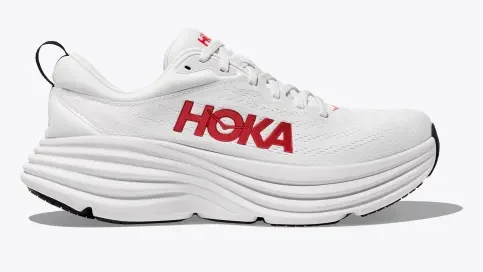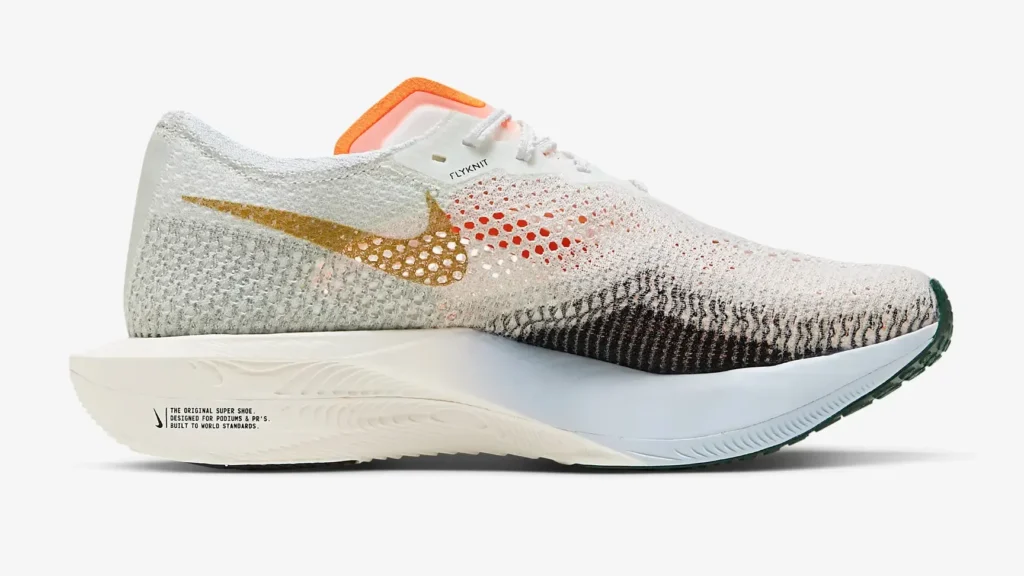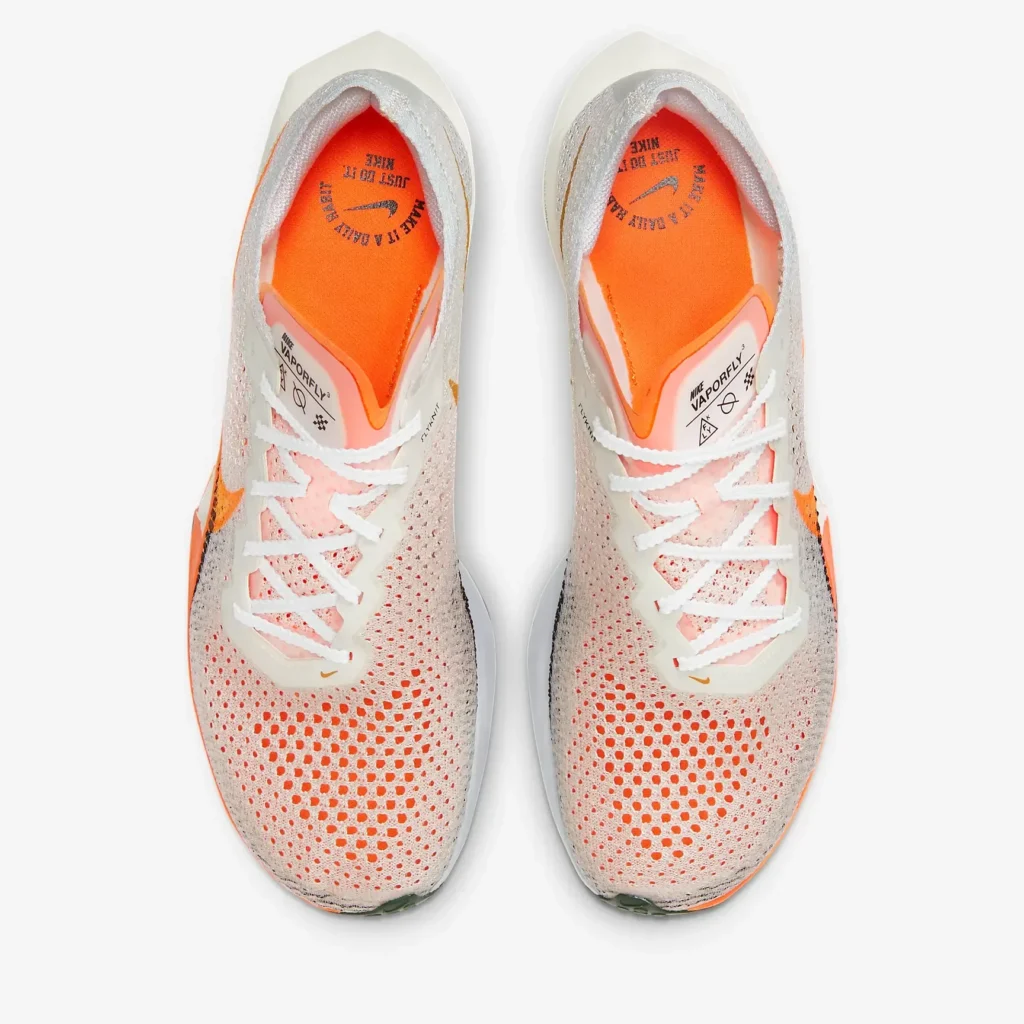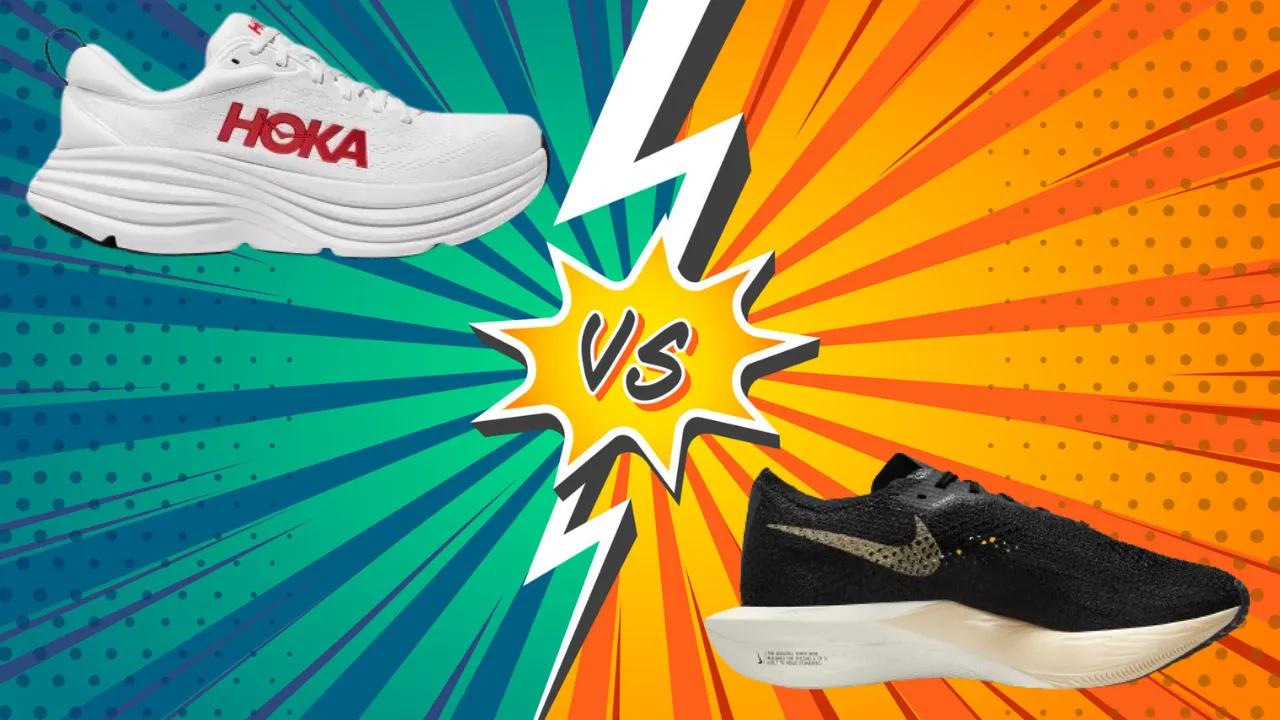Hey there, fellow runners and shoe enthusiasts! Ready to dive into the world of running shoes? Today, we’re putting two popular models head-to-head: the Hoka Bondi 8 and the Nike Vaporfly 3.
Whether you’re just starting your running journey or you’re a seasoned marathoner, this comparison will help you find the perfect shoe for your feet.
We’ll break down comfort, performance, and all the cool features these shoes offer. So, lace up and let’s get moving – it’s time to see how these two running powerhouses stack up against each other!
key takeaways:
- The Hoka Bondi 8 excels in comfort and durability, making it ideal for everyday training, long runs, and all-day wear. It offers plush cushioning and a stable ride, perfect for those prioritizing comfort over speed.
- The Nike Vaporfly 3 is designed for performance and speed, featuring responsive ZoomX foam and a carbon fiber plate. It’s the go-to choice for race days and runners looking to set personal bests.
- In terms of fit, the Bondi 8 offers a more traditional, accommodating fit, while the Vaporfly 3 introduces innovations like a wider toe box and a more personalized Flyknit upper.
- For specific activities, the Bondi 8 outperforms in walking and standing all day, while the Vaporfly 3 shines in high-speed running and racing scenarios.
- Value for money depends on intended use: the Bondi 8 offers better value for everyday runners, while the Vaporfly 3’s higher price point is justified for competitive runners seeking top-tier performance.
Comparison Table between Hoka Bondi 8 And Nike Vaporfly 3:
| Feature | Hoka Bondi 8 | Nike Vaporfly 3 |
|---|---|---|
| Stability | Neutral to Moderate | Neutral |
| Flexibility | Moderate | High |
| Sizing | True to size | True to size, wider toe box |
| Weight | 10.80 oz (306g) | Approx. 7.05 oz (200g) |
| Cushion | Plush, soft | Responsive, springy |
| Outsole | Durabrasion rubber | Waffle pattern rubber |
| Midsole | Lightweight, resilient foam | Nike ZoomX foam |
| Upper | Engineered mesh | Flyknit |
| Retail Price | $165 | $260 |
Hoka Bondi 8 vs Nike Vaporfly 3: Features Comparison
Materials: outsole, insole, upper sole
The Hoka Bondi 8 boasts a Durabrasion rubber outsole designed for durability and traction. Its insole features an Ortholite® hybrid sockliner for added comfort, while the upper is constructed with engineered mesh containing 50% recycled polyester. This combination offers breathability and eco-friendliness.


In contrast, the Nike Vaporfly 3 utilizes a Waffle pattern outsole with perforations for multi-surface grip and weight reduction. Its insole isn’t specified, but the midsole uses Nike ZoomX foam for energy return.
The upper is crafted with Flyknit technology, providing a soft, conforming fit with targeted breathability. Both shoes prioritize lightweight materials, but Nike’s approach leans more towards performance-oriented design.
Durability
When it comes to durability, the Hoka Bondi 8 seems to have an edge. Its Durabrasion rubber outsole is specifically engineered for longevity, making it suitable for high-mileage runners. The shoe’s construction, including the 87% recycled polyester strobel board, adds to its overall robustness.
On the other hand, the Nike Vaporfly 3 focuses more on performance than durability. While its updated thin outsole rubber claims to maintain durability despite using less material, it’s primarily designed for race days rather than daily training.
The Flyknit upper of the Vaporfly 3 is durable but may wear faster than the Bondi 8’s mesh upper under heavy use. For runners seeking a shoe for frequent, long-term use, the Bondi 8 might be the more durable option.
Fit
The Hoka Bondi 8 offers a comfortable fit with its partially gusseted tongue and memory foam collar that cradles the ankle. The engineered mesh upper provides a snug yet breathable feel. It’s designed to accommodate a range of foot shapes, making it a versatile option for many runners.


The Nike Vaporfly 3, however, introduces some fit innovations. It features a wider toe box for a roomier fit, addressing a common complaint about previous models. The Flyknit upper is engineered to conform to the foot, offering a more personalized fit.
The Vaporfly 3 also includes light padding on the tongue to reduce lace pressure. While both shoes aim for a comfortable fit, the Vaporfly 3 might edge out for those seeking a more tailored, race-day fit.
Cushioning
Cushioning is where these shoes diverge significantly. The Hoka Bondi 8 is renowned for its plush cushioning, featuring a high bed of soft, ultralight resilient foam. This design provides exceptional impact absorption and comfort, ideal for long runs or those seeking maximum cushioning.
The Nike Vaporfly 3, in contrast, utilizes Nike ZoomX foam, which offers a different kind of cushioning experience. ZoomX is highly responsive and energy-returning, creating a springy, bouncy feel.
The Vaporfly 3 also incorporates a full-length carbon fiber plate for added propulsion. While both shoes offer premium cushioning, the Bondi 8 focuses on soft comfort, while the Vaporfly 3 aims for responsive performance.
Stability
In terms of stability, the Hoka Bondi 8 provides a balanced approach. It features a symmetrical bed of cushion without additional prescriptive technologies, offering what Hoka calls “inherent stability.” The shoe’s wide base and meta-rocker geometry contribute to a stable ride without being overly controlling.
The Nike Vaporfly 3, while primarily a neutral shoe, incorporates some stability features. Its midsole bulge near the heel is designed to reduce weight on the inside of the foot, promoting a more stable ride.
However, its highly responsive cushioning and race-oriented design may feel less stable to some runners. For those prioritizing stability, especially during longer runs, the Bondi 8 might provide a more reassuring platform.
Value For Money
Assessing value for money requires considering both price and intended use. The Hoka Bondi 8, priced at $165, offers excellent value for daily training, long runs, and even walking. Its durability and versatility make it a solid investment for regular use. The shoe’s comfort features and recycled materials add to its value proposition.
The Nike Vaporfly 3, at $260, represents a significant investment. However, for competitive runners or those seeking top-tier race-day performance, it may justify its price.
The advanced technologies like ZoomX foam and the carbon fiber plate offer race-winning potential. Ultimately, the Bondi 8 provides better value for everyday runners, while the Vaporfly 3’s value shines for those focused on racing and personal bests.
Performance Testing:
For Walking
For walking, the Hoka Bondi 8 takes the lead. Its plush cushioning and meta-rocker design create a smooth, comfortable experience for extended periods on your feet. The shoe’s durability and stable platform make it ideal for long walks or all-day wear. The memory foam collar adds to overall comfort.
In contrast, the Nike Vaporfly 3, while comfortable, is overbuilt for walking. Its responsive ZoomX foam and carbon fiber plate are designed for running efficiency, which may feel unnecessary and potentially unstable for walking. The Bondi 8’s softer cushioning and wider base provide a more natural and comfortable walking experience, making it the better choice for this activity.
For Running
For running, the choice depends on your goals. The Hoka Bondi 8 excels in comfort for long, easy runs. Its plush cushioning reduces impact, making it ideal for recovery runs or high-mileage training. The lightweight, resilient foam provides a consistent feel mile after mile.
However, the Nike Vaporfly 3 is engineered for speed and performance. Its ZoomX foam and carbon fiber plate deliver exceptional energy return, propelling you forward with each stride.
The Vaporfly 3’s lighter weight (about 3.75 oz less than the Bondi 8) is a significant advantage in races. For everyday training runs, the Bondi 8 is more suitable, but for race day or speed work, the Vaporfly 3 has a clear edge.
For Standing All Day
When it comes to standing all day, the Hoka Bondi 8 is the clear winner. Its maximum cushioning design, featuring a high bed of soft, ultralight resilient foam, provides superior comfort for prolonged standing. The shoe’s wide, stable base helps reduce fatigue, while the Ortholite® hybrid sockliner adds an extra layer of underfoot comfort.
The Nike Vaporfly 3, while comfortable, is not designed for static activities. Its highly responsive cushioning and propulsive design are optimized for running motion, which may feel less comfortable when standing still for extended periods. The Bondi 8’s focus on all-day comfort makes it the better choice for those who spend long hours on their feet.
For Plantar Fasciitis
For runners dealing with plantar fasciitis, both shoes offer benefits, but in different ways. The Hoka Bondi 8’s maximum cushioning and meta-rocker design can help alleviate pressure on the plantar fascia by promoting a smoother foot motion. Its plush, stable platform provides consistent support, which can be beneficial for those with this condition.
The Nike Vaporfly 3, while not specifically designed for plantar fasciitis, offers unique advantages. Its highly responsive ZoomX foam and carbon fiber plate can reduce stress on the foot by promoting efficient running form. However, the Bondi 8’s softer cushioning and more structured support may be more comfortable for those with acute plantar fasciitis pain.
Conclusion: Which Is Better For You
Choosing between the Hoka Bondi 8 and Nike Vaporfly 3 ultimately depends on your specific needs. The Bondi 8 is the go-to for comfort, everyday training, and all-day wear. It’s ideal for those prioritizing cushioning and durability.
The Vaporfly 3, on the other hand, is the speed demon’s dream, perfect for race days and chasing personal bests. If you’re a casual runner or need all-day comfort, lean towards the Bondi 8.
But if you’re aiming to shave seconds off your race times, the Vaporfly 3 is your weapon of choice. Consider your running goals, budget, and comfort preferences to make the best decision for your feet.

